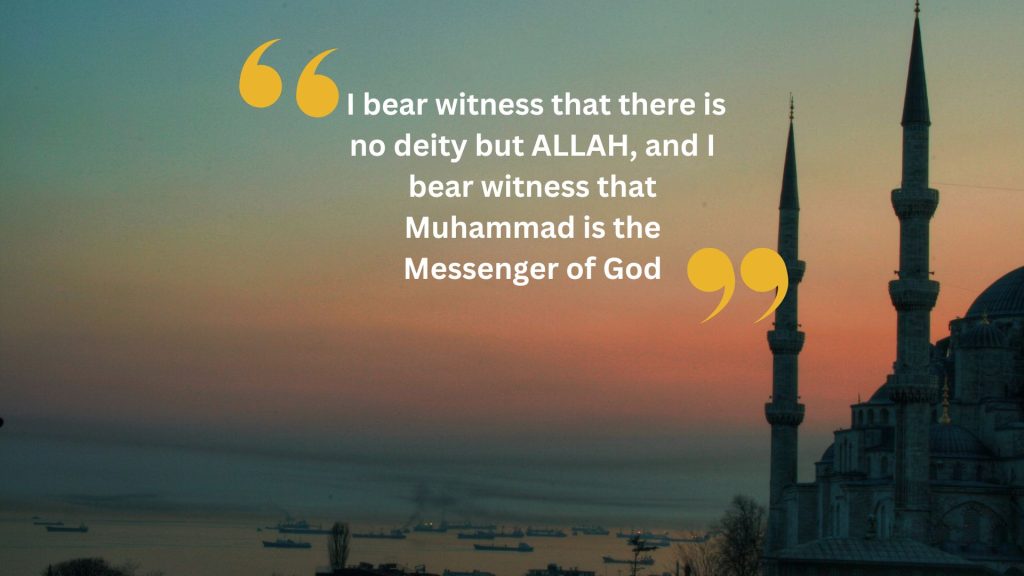Shahadah – Faith
The First Pillar of ISLAM
The Shahadah ( Arabic: الشَّهَادَةُ aš-šahādatu) holds a paramount position in Islam as an essential declaration of faith, encapsulating its core beliefs. The meaning of Shahadah in Arabic is “, “which translates to “testimony” or “declaration.” It is recited by Muslims worldwide, signifying their commitment to the oneness of God and the prophethood of Muhammad.
It believes in God’s oneness (tawhid) and accepts Muhammad as God’s messenger. This declaration is a verbal affirmation and a profound expression of one’s faith and submission to God.
Components of the Shahadah
Comprising two main parts, it begins with “lā ʾilāha ʾillā -llāh” (“There is no deity except God”), affirming the monotheistic nature of Islam. It continues with “muḥammadun rasūlu llāh” (“Muhammad is the Messenger of God”), acknowledging Muhammad’s role as the final prophet and messenger of God. In Shia Islam.

Theological Context
It holds immense theological significance in Islam, serving as a foundational creed that encapsulates the core beliefs of the faith. At its heart, it proclaims the absolute oneness of God (Tawhid), the central tenet of Islamic monotheism. This declaration of the oneness of God emphasizes the fundamental Islamic belief that there is no deity worthy of worship except Allah.
Moreover, by affirming the prophethood of Muhammad, it acknowledges the finality and completeness of the message he brought. It underscores his pivotal role as the last in a line of prophets sent to guide humanity.
Ritual and Worship
In Islamic practice, the recitation of it is deeply intertwined with various aspects of worship and daily life. It is recited by Muslims as a declaration of faith, often in conjunction with the Adhan (call to prayer), which announces the times of the five daily prayers.
The Shahada is said during prayer, especially in the final sitting. It’s part of the Tashahhud, a declaration of faith. People also say it during important times, like when a baby is born, to welcome them into the Muslim community, and when someone is dying, to show they still believe in Islam.
Historical Development
The formulation and adoption of it as a formal declaration of faith evolved, reflecting the development of Islamic theology and practice. While the concept of monotheism and the prophethood of Muhammad are rooted in the teachings of the Quran, the specific wording of it began to appear in the late seventh century.
It gained prominence on coins and in monumental architecture, signifying its role as a unifying creed of the burgeoning Islamic civilization. The formalization of this pillar of Islam highlights its pivotal position in Islamic theology, symbolizing the essence of Islamic monotheism and the finality of prophethood in Muhammad.
Cultural and Artistic Significance
Its profound impact extends beyond theology into the world of culture and art celebrated as a symbol of Islamic identity and unity.
In architecture, you often see the declaration of faith displayed in mosques, palaces, and Islamic buildings. It’s a way to show faith visually and remind people about the important beliefs of Islam. This architectural use reflects the builders’ religious devotion and adds a spiritual dimension to the space’s beauty.
Furthermore, the declaration of faith holds significance in Islamic flags, frequently appearing as a central motif. Its inclusion symbolizes the faith and unity of Muslim communities, transcending linguistic and cultural barriers. This symbolic use underscores its universal appeal and evokes pride and belonging among Muslims worldwide.
The declaration of faith has been depicted in various forms, both in Islamic art and European depictions of Islamic motifs. Islamic calligraphy highlights its beauty and artistic merit. Calligraphers adorn it with intricate designs, making it art that transcends words alone.
This artistic representation showcases the rich tradition of Islamic art and underscores the universal message of monotheism and prophethood encapsulated in the declaration.

Importance of the Shahadah
FAQs
Is reciting it sufficient to become a Muslim?
Yes, reciting it sincerely and with understanding is the first step to becoming a Muslim. The declaration of faith signifies one’s acceptance of Islam’s core beliefs.
What does it mean to Muslims?
A declaration of faith affirms God’s oneness and Muhammad’s prophethood. It serves as a constant reminder of the fundamental beliefs of Islam and is recited in various religious rituals and practices.
Why is the Shahadah important in Islam?
It is the foundational creed of Islam, encapsulating its core beliefs. It is a unifying force for Muslims worldwide, symbolizing their shared faith and identity.
Are there different versions of the Shahada?
The basic form of this pillar of Islam is consistent across all Sunni Muslims, affirming the oneness of God and the prophethood of Muhammad.
Can non-Muslims recite the Shahadah?
While it is a declaration of faith for Muslims, non-Muslims are welcome to recite it if they sincerely wish to embrace Islam and its beliefs.
Conclusion
As the fundamental declaration of faith in Islam, it holds immense significance for Muslims worldwide. It is a unifying creed, affirming God’s oneness and Muhammad’s prophethood. The Shahadah’s theological, ritual, and cultural importance is evident in its role in Islamic worship, its use in architecture and art, and its impact on shaping Islamic civilization.
It symbolizes Islamic identity and pride, inspiring Muslims in their faith and daily lives. It embodies the timeless message of monotheism and prophethood at the core of Islam.





